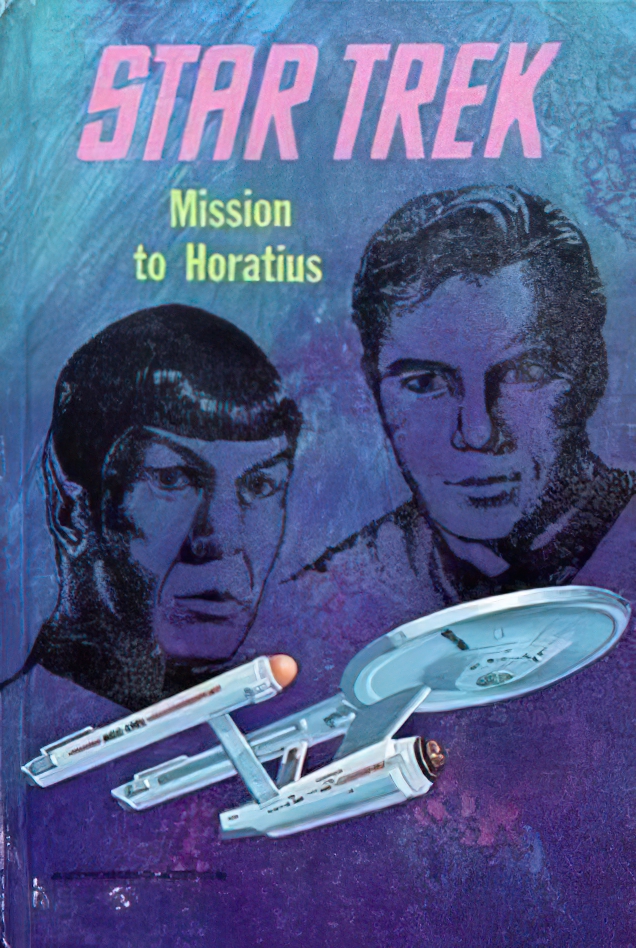 Story: The crew of the U.S.S. Enterprise is growing restless after months without shore leave. Unfortunately, a distress signal has been sent to Star Fleet from the Horatius system and Captain James T. Kirk and the Enterprise are given the mission to find out which of the distant planets of the system has sent the message and help if they can. When they arrive at the system in question they find three planets colonized by humans, all in various stages of stunted development. Travelling to each one by one, the crew of the Enterprise try to determine who is the victim and who is the aggressor.
Story: The crew of the U.S.S. Enterprise is growing restless after months without shore leave. Unfortunately, a distress signal has been sent to Star Fleet from the Horatius system and Captain James T. Kirk and the Enterprise are given the mission to find out which of the distant planets of the system has sent the message and help if they can. When they arrive at the system in question they find three planets colonized by humans, all in various stages of stunted development. Travelling to each one by one, the crew of the Enterprise try to determine who is the victim and who is the aggressor.
Review: “Mission To Horatius” has the distinction of being the first original Star Trek novel, published two years before James Blish’s “Spock Must Die”. It is also the only one published during the show’s original run. Reflecting the view of the day that Science Fiction was meant for children, “Mission To Horatius” was printed in a hardcover format similar to the “Hardy Boys†and “Nancy Drew†novels (and proudly boasts of being an “Authorized TV Adventure†on the spine).
Author Mack Reynolds does a creditable job capturing the feel of the characters. Although some of the dialogue seems a bit off, everyone at least acts pretty close to their television counterparts. Bones and Spock spar, Scotty claims that Kirk asks the impossible and there’s even some of the classic Star Trek wit on display. Reynolds obviously got a handle on the characters, but not on all the details of the show. At one point, McCoy declares that he has had to put over forty crew members into stasis to ward off “space cafard,†a condition brought on by the lack of shore leave. When told, Kirk seems convinced that the loss of forty crew members would cripple the ship. Any fan worth his salt knows that the Enterprise has a crew of over four hundred, so forty wouldn’t really put a dent in it. Small things like detract a bit from the story, but will really only bother purists.
The biggest innovation for the story is the multiple locales (impossible on the show due to budget restraints). It allows for the story to branch into different directions and adds a smidgeon of complexity. Unfortunately, it also provides the most irritating aspect of “Mission to Horatius”: the dreadful simplicity of the humans the crew meets (which could often be said about the show, to be honest). The planets the crew visit are Neolithia (because they’re basically cavemen), Mythra (because of their quasi-religion, I guess), and Bavarya (because they are essentially Nazis). It’s with that third group that things really get out of hand. Not only is their leader called “Nummer Einâ€, they are said to be “the elite of the Teutonic peoplesâ€, they use doppelgängers and the leader’s daughter is named Anna Schickle (no doubt in reference to Hitler’s father’s birth name, Schicklgruber). I suppose that children of 1968 would have no problem with these things, but as an adult reading in 2006, they lead to many eye-rolling moments.
Also, since it is a book written for children, don’t expect any of the character development found in the later novels. This actually makes it more in line with the show (which wasn’t known for too much character material), so I don’t personally have a problem with that. In the end, I found Mission To Horatius to be an intersting read from a historical perspective, but unsatisfying on the level of pure entertainment. Despite some nice touches, it’s just too simple for me. Younger readers (it’s original intended audience, remember) will most likely find it engaging enough and it certainly shouldn’t prove too cumbersome for those on the reading level of the more popular modern children’s books. Kids weaned on “A Series Of Unfortunate Events” or the Harry Potter novels may find it a bit light, but I think it would still be entertaining enough for any young Star Trek fans.
Year: 1968, re-issued 1999
Author: Mack Reynolds
Publisher: Whitman, re-issue by Pocket Books
Pages: 210




